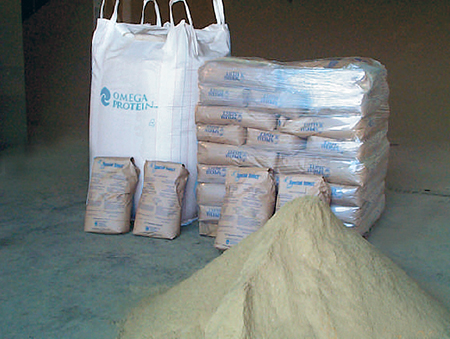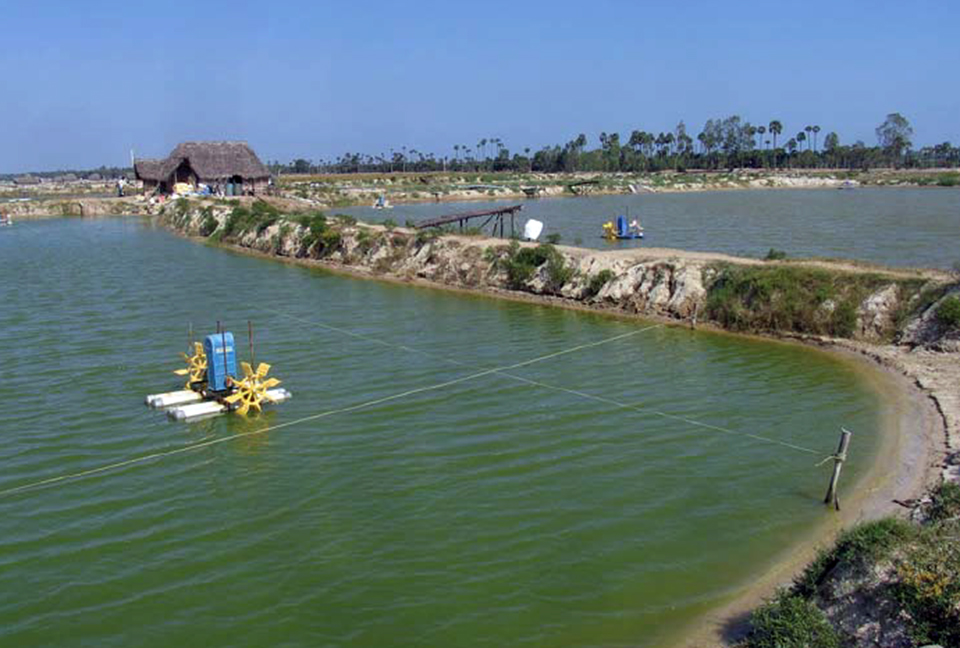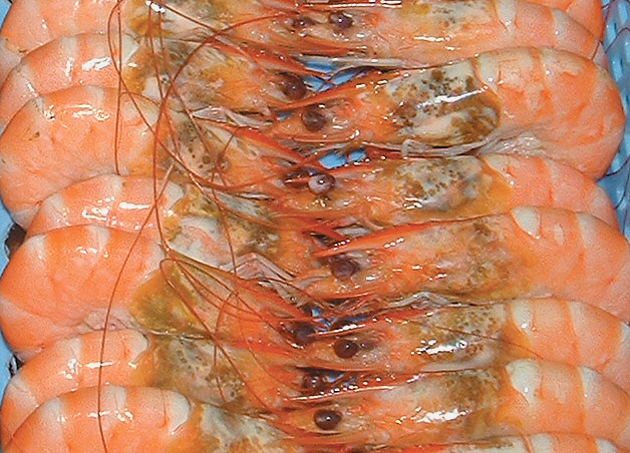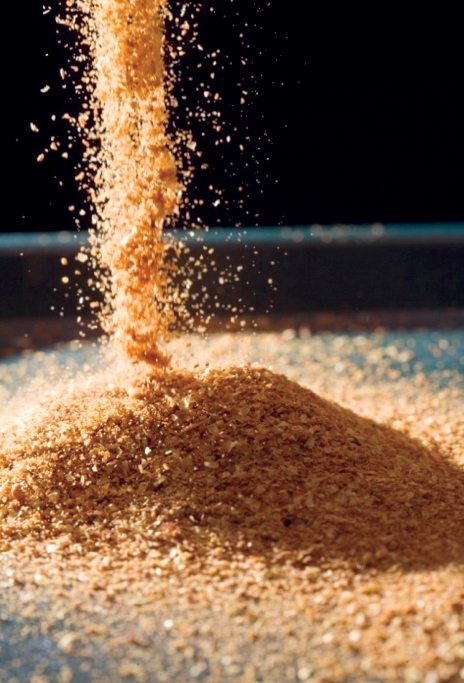Menhaden product superior in terms of protein, dry matter, phosphorus, more

Fishmeal is the main protein source in practical diets for shrimp, and also an important source of nutrients like cholesterol and omega-3 fatty acids. Its inclusion rates in feed vary with shrimp species from 40 percent for the more carnivorous to as less than 25 percent for the more omnivorous shrimp.
Regardless of the species, the nutritional value of fishmeal is of critical importance for nutritionists and shrimp feed manufacturers who want to achieve the lowest formula cost with the highest nutritional value, and shrimp producers looking to maximize their production and feed conversion.
Quality and digestibility
Fishmeal quality is heavily dependent on the freshness of the fish, oxidation of the fats, and digestibility. Protein digestibility depends largely on the processing conditions under which the fishmeal is produced.
Fishmeal dryers are designed to remove large amounts of moisture without exposing the sensitive protein fraction to excessive temperatures, which reduces digestibility. Drying efficiency is achieved by using relatively high temperatures at the outset of the drying process, when evaporative cooling prevents scorching of the meal. Much lower temperatures are used at the end of the drying process, when moisture levels are minimal.
Indirect steam and hot air dryers are generally considered superior to direct-flame dryers in delivering consistent quality. However, new-generation direct-flame dryers can also produce top-quality fishmeal through careful control of initial and final temperatures.
Study setup
With support from Omega Protein, Inc., the authors recently conducted a study at the University of Nuevo León in Monterrey, Mexico, to determine the protein, dry matter, energy, and phosphorous digestibilities of three commercial fishmeals fed to western white shrimp, (Litopenaeus vannamei). The fishmeals tested included one processed by indirect steam drying (Mexican-1) and two by direct flame: Omega Protein Menhaden Special Select and Mexican-2.
Experimental diets
The experimental diets and one reference diet were prepared containing 1 percent chromic oxide as an inert marker (Table 1). The main ingredients were ground through a No. 35 screen and then mixed for 15 minutes in a food mixer. Water was added to the mix to facilitate pelleting through a meat grinder equipped with a 1.6-mm-diameter die. The pellets were then dried in a convection oven at 100 degrees-C for eight minutes, allowed to cool, and stored at 4 degrees-C.
Bortone, Reference and test diet formulas, Table 1
| Ingredients | Reference (Diet 1) | Mexican-1 (Diet 2) | Mexican-2 (Diet 3) | Menhaden (Diet 4) |
|---|
Ingredients | Reference (Diet 1) | Mexican-1 (Diet 2) | Mexican-2 (Diet 3) | Menhaden (Diet 4) |
|---|---|---|---|---|
| Steam-dried sardine meal | 300 | |||
| Flame-dried sardine meal | 300 | |||
| Flame-dried menhaden meal | 300 | |||
| Steam-dried Chilean fishmeal | 97 | 67.35 | ||
| Wheat flour | 619 | 429.8 | ||
| Soybean meal | 100 | 69.43 | ||
| Shrimp meal | 30 | 20.83 | ||
| Methionine | 2 | 1.39 | 1.39 | |
| Fish oil | 25 | 17.36 | 17.36 | 17.36 |
| Soy lecithin (crude) | 48.5 | 33.68 | 33.68 | 33.68 |
| Wheat gluten | 60 | 41.66 | 41.66 | 41.66 |
| Additives: | ||||
| Chromic oxide | 10 | 10 | 10 | 10 |
| Stay C | 0.5 | 0.5 | 0.5 | 0.5 |
| Mineral mix | 2.5 | 2.5 | 2.5 | 2.5 |
| Vitamin mix | 2.5 | 2.5 | 2.5 | 2.5 |
| Mold inhibitor | 0.5 | 0.5 | 0.5 | 0.5 |
| Ethoxiquin | 0.5 | 0.5 | 0.5 | 0.5 |
| Cholesterol | 2 | 2 | 2 | 2 |
The apparent digestibility of the test ingredients was determined following Cho and Slinger (1979) using a test diet wherein the test ingredients replaced 30 percent of the complete formula of the reference diet. The chemical composition, gross energy, and phosphorus of the experimental diets were determined using standard laboratory methods. The dry matter loss and crude protein loss after one-hour immersion of the experimental diets in synthetic 30-ppt seawater at 28 degrees-C were also determined and replicated 3 times per diet.
Feces collection
Test parameters were determined from feces collected from four replicate tanks per diet treatment. Each tank held six shrimp of 8 grams initial weight. Animals were fed twice a day at a fixed daily ration of 4 percent of their biomass. Feces collection started after two days of holding and feeding the experimental animals.
Feces were collected 90 to 120 minutes after feeding by first removing uneaten feed and then siphoning off the feces, which were immediately rinsed with distilled water and stored in a freezer. Feces were collected for 12 days and pooled into sample of at least 3 grams (wet weight) per tank. Chromic oxide and nitrogen in the experimental diets and feces were analyzed using a modified micro-Kjeldahl method.
Statistical analysis
The apparent dry matter and apparent protein digestibilities of the diets were calculated using the equations of Maynard et al. (1981). Additionally, these values were adjusted for losses by leaching before feed ingestion. The ingredients’ apparent dry matter, crude protein digestibility values, apparent energy, and phosphorus digestibility were also calculated.
The digestibility coefficients calculated from the feces samples were evaluated by analysis of variance and Duncan’s multiple range test to first determine whether significant differences existed among the experimental diets, and then identify where they occurred.
Proximal composition
The proximal compositions of the fishmeals and diets tested are presented in Tables 2 and 3, respectively. The Mexican fishmeals, made from sardines, had proximal compositions similar to that of the menhaden meal, except for the lower fat level of the Mexican-2 sample.
Bortone, Fishmeal composition (%), Table 2
| Parameter | Mexican-1 (Diet 2) | Mexican-2 (Diet 3) | Mexican-4 (Diet 4) |
|---|
Parameter | Mexican-1 (Diet 2) | Mexican-2 (Diet 3) | Mexican-4 (Diet 4) |
|---|---|---|---|
| Moisture | 6.93 | 8.60 | 6.13 |
| Protein | 62.50 | 62.04 | 62.84 |
| Lipid | 11.19 | 8.00 | 10.85 |
| Ash | 17.30 | 19.12 | 18.49 |
| Phosphorus | 2.68 | 2.90 | 2.75 |
| Calcium | 4.64 | 5.72 | 4.76 |
| Analyzed energy content (Kcal/g) | 4.52 | 4.62 | 4.49 |
| Calculated energy content (Kcal/g) | 4.56 | 4.23 | 4.55 |
Bortone, Proximal analysis of diets (%) and dry matter, crude protein, and phosphorus losses, Table 3
| Parameter | Reference (Diet 1) | Mexican-1 (Diet 2) | Mexican-2 (Diet3) | Menhaden (Diet 4) |
|---|
Parameter | Reference (Diet 1) | Mexican-1 (Diet 2) | Mexican-2 (Diet3) | Menhaden (Diet 4) |
|---|---|---|---|---|
| Moisture | 8.63 | 8.25 | 9.35 | 8.18 |
| Protein | 26.09 | 36.37 | 36.23 | 36.43 |
| Lipid | 9.85 | 9.88 | 8.78 | 9.63 |
| Ash | 4.34 | 8.30 | 9.14 | 8.55 |
| Fiber | 0.95 | 0.80 | 0.87 | 1.08 |
| Nitrogen-free extract | 50.15 | 36.40 | 35.63 | 36.13 |
| Phosphorus | 0.59 | 1.24 | 1.33 | 1.31 |
| Calcium | 0.53 | 1.57 | 1.81 | 1.55 |
| Analyzed energy content (Kcal/g) | 4.30 | 4.41 | 4.22 | 4.39 |
| Calculated energy content (Kcal/g) | 4.45 | 4.47 | 4.32 | 4.44 |
The three test diets had homogeneous proximal compositions, with protein and ash contents higher than those of the reference diet. The phosphorus and calcium contents were congruent with the global ash contents, with slightly higher values in the Mexican-2 diets, as expected in view of the higher ash content in the corresponding fishmeal.
Dry matter loss by immersion in seawater was homogeneous among the four diets at 8 percent, a normal value for diets made at the laboratory. Crude protein loss, however, was higher in the test diets, indicating a higher proportion of soluble protein in the test fishmeals than the reference diet. Loss of phosphorus in the Mexican-2 test diet was five points lower than the other diets.
Digestibility coefficients
Digestibility coefficients for protein, dry matter, phosphorus, and energy are presented in Table 4.
Bortone, Apparent protein, dry matter, phosphorus, and energy digestibilities in three types of fishmeal, Table 4
| Parameter | Mexican-1 (Diet 2) | Mexican-2 (Diet 3) | Menhaden (Diet 4) |
|---|
Parameter | Mexican-1 (Diet 2) | Mexican-2 (Diet 3) | Menhaden (Diet 4) |
|---|---|---|---|
| Apparent protein digestibility | 73.9 ± 2.7a | 75.0 ± 1.9a | 86.3 ± 1.3b |
| Apparent dry matter digestibility | 72.9 ± 2.2b | 61.3 ± 2.0a | 78.3 ± 2.7c |
| Apparent phosphorus digestibility | 27.7 ± 6.3b | 13.9 ± 4.3a | 37.7 ±3.2c |
| Apparent energy digestibilitry | 83.2 ± 3.7b | 67.7 ± 4.5a | 95.7 ± 3.4c |
The menhaden fishmeal showed significantly (P < 0.001) higher digestibility values than the Mexican sardine meals for protein, dry matter, phosphorus, and energy. Protein digestibility in the menhaden meal (86.3 percent) was 12 points higher than the Mexican sardine meals. This indicated improvements in processing conditions can have a positive effect, even using direct-flame dryers.
Regarding dry matter, phosphorus, and gross energy digestibility, the Mexican-1 fishmeal was 5, 10, and 12 points lower, respectively, than the menhaden fishmeal. There were even higher significant differences between the Mexican-2 and menhaden fishmeals for the same nutrients (18, 24, and 17 points, respectively). When leaching was considered by correcting the digestibility values for the nutrients that were not assimilated, these differences were maintained or increased (Table 5).
Bortone, Apparent protein and dry matter digestibilities, Table 5
| Parameter | Mexican-1 (Diet 2) | Mexican-2 (Diet 3) | Menhaden (Diet 4) |
|---|
Parameter | Mexican-1 (Diet 2) | Mexican-2 (Diet 3) | Menhaden (Diet 4) |
|---|---|---|---|
| Apparent protein digestibility | 71.8 ± 2.9a | 71.4 ± 2.2a | 83.8 ± 1.6b |
Conclusion
The menhaden fishmeal was superior to both Mexican fishmeals in terms of protein, dry matter, phosphorus, and energy digestibility. These results were not due to an excess of soluble nutrients, because the differences remained after correcting the data for the nutrients lost by leaching in seawater.
Because the Mexican fishmeals had ash content similar to that of the menhaden fishmeal, it can be speculated that the main differences in nutrient digestibility were due to specific processing conditions and not the method of drying or ash content. Controlling processing conditions resulted in increased digestibility and overall higher quality in the menhaden fishmeal.
Additional research is needed to further investigate the effects of processing conditions to determine the optimum area where fishmeal digestibility can be additionally improved and correlate this information to other factors like ash and total protein content.
Note: Cited references and further details of the experimental procedures used in this study are available from Dr. Eugenio Bortone.
(Editor’s Note: This article was originally published in the October 2003 print edition of the Global Aquaculture Advocate.)
Now that you've reached the end of the article ...
… please consider supporting GSA’s mission to advance responsible seafood practices through education, advocacy and third-party assurances. The Advocate aims to document the evolution of responsible seafood practices and share the expansive knowledge of our vast network of contributors.
By becoming a Global Seafood Alliance member, you’re ensuring that all of the pre-competitive work we do through member benefits, resources and events can continue. Individual membership costs just $50 a year.
Not a GSA member? Join us.
Author
Tagged With
Related Posts

Responsibility
Indian farmers consider white shrimp
India farmers are considering ways to boost production. If approved on a wider basis, production of Pacific white shrimp could boost overall yields.

Health & Welfare
Proactive measures address hepatopancreas problems in HOSO shrimp
A shrimp's ruptured or discolored hepatopancreas is from a combination of factors involving nutrition, stress or toxins at various production chain levels.

Aquafeeds
A look at corn distillers dried grains with solubles
Corn distillers dried grains with solubles are an economical source of energy, protein and digestible phosphorus to reduce feed costs and fishmeal usage.

Aquafeeds
A look at protease enzymes in crustacean nutrition
Food digestion involves digestive enzymes to break down polymeric macromolecules and facilitate nutrient absorption. Enzyme supplementation in aquafeeds is a major alternative to improve feed quality and nutrient digestibility, gut health, compensate digestive enzymes when needed, and may also improve immune responses.


